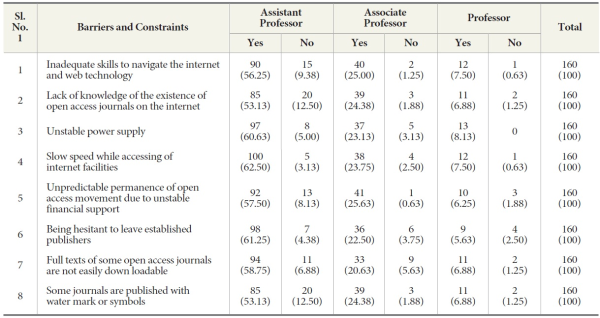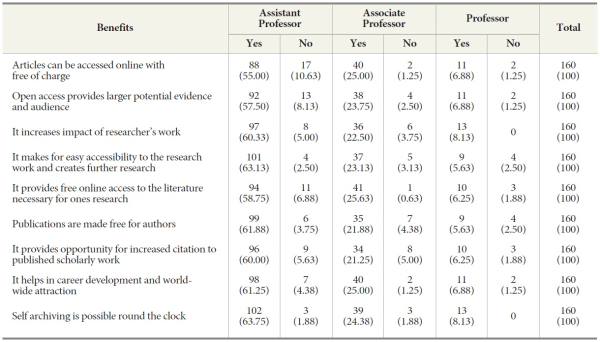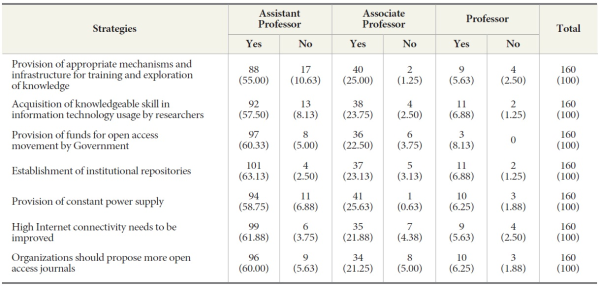ISSN : 2287-9099
A Critical Study on Attitudes and Awareness of Institutional Repositories and Open Access Publishing

M. Tamizhchelvan (Library Gandhigram Rural Institute-Deemed University)

Abstract
This paper discusses awareness of institutional repositories and open access publishing among faculty members in Annamalai University, Tamil Nadu, India. The authors distributed 200 questionnaires among the faculty members in Annamalai University. Out of 200 questionnaires, 160 responses (80.00%) were received from faculty members. The respondents mentioned the motivating factors while using an institutional repository and indicated the benefits, constraints and strategies to develop open access in publications. It is evident from the table that more than 95% among the average of the faculty members confirm the benefits of open access in publications. 150 (93.75%) of faculty members have awareness, 6 (3.75%) have no idea and 4 (2.50%) state no opinion about awareness of institutional repository and open access publishing.
- keywords
- Institutional repositories, open access publishing, benefits and constraints, user feedback
1. INTRODUCTION
There is a rapidly expanding stock of scientific knowledge. Open Access has become an increasingly strong movement in recent years. The aim is to make research literature, especially peer-reviewed academic articles, free for anyone in the world to access. Yet access to this pool of knowledge is often difficult because of the relatively high cost of journals in their printed and web–based versions. Many of the Openaccess journals are scholarly journals that are available online to the reader. According to Wikipedia, Open Access journals are “without financial, legal, or technical barriers other than those inseparable from gaining access to the internet itself’”. Some are subsidized, and some require payment on behalf of the author. Priti Jain (2012) commented, “A commitment to scholarly work carries with it a responsibility to circulate that work as widely as possible: this is the access principle. The right to know and the right to be known are inextricably mixed”. Another vital issue is that removing access barriers will accelerate research, enrich education and share learning. There is therefore a critical need to make research results available to as many academics and elite classes as possible free of charge. Because of this need, concerned institutions and organizations have felt challenged. One such initiative, which has been undertaken to demonstrate that scientific knowledge need not be published in forms that make access expensive, is the Budapest Open Access Initiative.
2. INSTITUTIONAL REPOSITORIES
Institutional repositories have been established in academic and research libraries. University based institutional repositories manage, disseminate, and preserve where appropriate, digital materials created by the institution and its community members. They also organize and access these materials, (Lynch, 2003). A survey conducted by the Coalition for Networked
Information (CNI) found that research libraries have taken on a leadership role in both policy formulation and operational deployment roles for institutional repositories at research universities (United States Higher Education Institutions, 2005).
The libraries’ role towards build up in institutional repositories is articulated as follows (Crow, 2002):
-
1. Academic libraries have the responsibility for managing and archiving all printed materials in IRs.
-
2. Library program and budgets will have to support faculty open access publishing activities.
-
3. To the organizational imperatives to invest in the future, institutional repositories offer a compelling response.
-
4. Libraries are to provide the document preparation expertise to help authors contribute their research to IRs.
3. OPEN ACCESS - CONCEPT AND DEFINITION
Repositories are increasingly being made more ‘open’ to make content accessible to wider user groups, sometimes at a global level. Not all repositories are open: some are designed to support sharing within a specific group and are sometimes described as ‘closed’. These repositories often require authentication and some have varying levels of access and 'degrees of openness'. “Open Access” is a term that is used in a specific sense and most often used in relation to collections of research papers.
According to the Budapest Open Access Initiative (BOAI), the concept of Open Access refers to “[the] free availability on the public internet, permitting any users to read, download, copy, distribute, print, search, or link to the full texts of these articles, crawl them for indexing, pass them as data to software, or use them for any other lawful purpose, without financial, legal, or technical barriers other than those inseparable from gaining access to the internet itself” (BOAI, 2003).
4. LITERATURE REVIEW
Manjunatha (2001) found in his studies, research scholars made awareness of Institutional Repositories and keen interest in access to IRs in their university. It shows that institutional level IRs have scope to build repositories. Barwick (2007) made efforts in setting up an institutional repository at Loughborough University and made available to the institutional access. Erickson et al. (2008) have applied the basic techniques to build an institutional repository for external resources like blogs, wikis, and other web resources. Managing the publication and sharing of research artifacts is within the individual’s scholarly network. There is steady increase in the usage of the repository model for archiving and sharing digital resources and in an itemtagging scheme that suggests user preference of the resource as a platform for enhancing professional rather than personal interests. User interactivity by way of textual scholarly discussions on the repository platform is however almost nonexistent (Asunka et al., 2011).
5. NEED FOR THE STUDY
The main aim of this study is to make an attempt to find out awareness of open access in publications and institutional repositories by the faculty members. The problem of this study is to find out the extent of benefits, constraints, and strategies to develop and improve the institutional repository and open access in publications among faulty members in Annamalai University.
6. OBJECTIVES OF THE STUDY
Based on the need of the study the following objectives are framed:-
-
1. To determine awareness about IR and open access publishing
-
2. To determine awareness about IR software and open access publishing
-
3. To know the sources from where users are aware about IR and open access publishing
-
4. To identify the motivating factors for using IR and open access publishing
-
5. To find out strategies to develop and improve the IR and open access in publications
7. METHODOLOGY
This study is to find out the awareness of institutional repositories and open access in publishing among faculty members in Annamalai University. The questionnaires were personally distributed to 200 faculty members among faculty members. Out of 200 questionnaires, 160 responses (80.00%) were received from faculty members. The collected data were analyzed and tabulated through statistical tools like simple percentages.
8. ANALYSIS AND INTERPRETATION
The frequency of 200 questionnaires was distributed to faculty members, including Assistant Professors, Associate Professors and Professors in Annamalai University to determine awareness of institutional repositories and open access in publishing in Table 1.
Table 1 shows the distribution of questionnaires to the faculty members in Annamalai University, Annamalai Nagar. Out of 200, 160 questionnaires were received from the faculty members and the response rate is 80%.
Table 2 shows the gender wise distribution of faculty members in Annamalai University based on this study. Among the total number of 105 Assistant Professors 80 (50.00%) are male and 25 (15.62%) are female. Out of 42 Associate Professors 30 (18.755) are male and 12 (7.50%) are female. In the Professor category, 8 (5.00%) are male and 5 (3.12%) are female out of 13 (8.12%). From the above discussion it is inferred that out of 160 faculty members, 118 (73.75%) respondents are male and the remaining 42 (26.25%) respondents are female.
The data presented in Table 3 shows the Awareness of Institutional Repository and Open Access Publishing stated by the faculty members in Annamalai University. Out of 105, 99 (61.88%) Assistant Professors have awareness of Institutional Repository and Open Access Publishing and 4 (2.50) Assistant Professors mention no awareness and 2 (1.25%) have no opinion about institutional repository and open access publishing. Out of 42 Associate Professors, 39 (24.38%) have the awareness of institutional repository and open access publishing, 2 (1.25%) of Associate professors
Table 3.
Awareness of Institutional Repositories and Open Access Publishing
Note. Figures in parentheses denote percentage.

Table 4.
Sources for Users’ IR and Open Access Publishing Awareness
Note. Figures in parentheses denote percentage.

have no knowledge about IR and one Associate Professor states no opinion about awareness. It is concluded from the table, that out of 160 faculty members, 150 (93.75%) have awareness, 6 (3.75%) have no idea, and 4 (2.50%) state no opinion about awareness of institutional repository and open access publishing.
Table 4 indicates the sources for users’ institutional repository and open access publishing awareness by the respondents from Annamalai University. Out of 160, 52 (32.50%) faculty members mention Workshop, Seminars and Orientation Program for getting sources for institutional repository and open access publishing; this number includes 35 (21.88%) Assistant Professors, 13 (8.13%) Associate Professors and 4 (2.50%) Professors. 30 (18.75%) faculty members mention library professionals and their assistants for getting sources for institutional repository and open access publishing; this number includes 19 (11.88%) Assistant Professors, 9 (5.63%) Associate Professors and 2 (1.25%) Professors.
Table 5 indicates reasons for developing institutional repository and open access publishing awareness by the respondents from Annamalai University. Out of 160, 22 (13.75%) faculty members mention two reasons equally such as, To increase the visibility of the institution as well as individuals and To digitize and preserve scholarly material on campus. In the same case 21(13.13%) equally mention two reasons, such as Response to administrative interest, and To participate in the scholarly communication process.
Table 6 shows the motivating factors stated for using institutional repositories in Annamalai University by faculty members. Among the total number of 160, 142 (88.75%) faculty members state that my work is deposited and quickly disseminated to all, and 151 (94.38%) faculty members choose the repository is well
Table 5.
Reasons for Developing a Repository and Open Access
Note. Figures in parentheses denote percentage.

indexed and archived. And, 149 (93.13%) state the public opinion of the university is increased, 133 (83.13) express depositing my work in the repository protects it from plagiarism and creates publicity, and 139 (86.88%) state my work is published alongside other high quality research and attracts the user.
As per Table 7 the data results indicate the support and coordination by the library staff members while using the institutional repository in the library. Out of 160, 101 (6.13%) Assistant Professors, 37 (23.13%) Associate Professors and 11 (6.88%) Professors state that librarians promote awareness through orientation to utilize the institutional repository. And, 99 (61.88%) Assistant Professors, 35 (21.88%) Associate Professors, and 9 (5.63%) Professors state Library staff are familiar with developing IRs and all content is appreciated. Further among 160, 102 (63.75%) Assistant Professors, 39 (24.38%) Associate Professors and 13 (8.13%) Professors, it is stated that the librarian is recommend for implementation to deposit in IRs.
The data presented in Table 8 shows the benefits in open access in publication indicated by faculty members in Annamalai University. Out of 160 faculty members, 102 (63.75%) Assistant Professors, 39 (24.38%)
Table 7.
LIS Professionals Support While Using Institutional Repositories
Note. Figures in parentheses denote percentage.

Associate Professors, and 13 (8.13%) Professors confirm that self archiving is possible round the clock in open access in publication and 101 (63.13%) Assistant Professors, 37 (23.13%) Associate Professors, and 9(5.63%) Professors state that open access makes for easy accessibility to the research work and create further research. And a further 96 (60.00%) Assistant Professors, 34 (21.25%) Associate Professors,
Table 9.
Barriers and Constraints Using Open Access in Publishing
Note. Figures in parentheses denote percentage.

and 10 (6.25%) Professors agree that open access helps in career development and world-wide attraction and audience. It is evident from the table that more than 95% among the average of the faculty members confirm the benefits to open access in publications.
Table 9 reveals the barriers or constraints while using open access publications. Out of 160 faculty members, 96 (56.25%) Assistant Professors, 40 (25.00%) Associate Professors, and 12 (7.50%) Professors mention inadequate skills to navigate the internet and web technology and 97 (60.63%) Assistant Professors, 37 (23.13%) Associate Professors, and 13 (8.13%) Professors also state unstable power supply is a main barrier while using open access in publications. And, following 98 (61.25%) Assistant Professors, 36 (22.50%) Associate Professors, and 9 (5.63%) Professors state being hesitant to leave established publishers and 94 (58.75%) Assistant Professors, 33 (20.63%) Associate Professors, and 11 (6.88%) Professors mention full texts of some open access journals are not easily down loadable as one barrier to using open access. So, it is revealed from the table that above 65% of the faculty members mention constraints while using open access in scholarly communications.
Table 10 indicates the Strategies to Develop and Improve Open Access for Publications mentioned by the faculty members in Annamalai University. Out of 160, 101 (63.33%) Assistant Professors, 37 (23.13%) Associate Professors and 11 (6.88%) Professors mention the establishment of institutional repositories and 99 (61.88%) Assistant Professors, 35 (21.88%) Associate Professors and 9 (5.63%) Professors indicate the strategies to develop open access in publications. And also the majority of faculty members mention as strategies the provision of funds for open access movement by Government and that organizations should propose more open access journals for the user community.
Table 11 displays the user feedback about institutional repository and open access publishing from faculty members in Annamalai University. Out of 160, 137 (85.63%) faculty members are satisfied with the institutional repository and open access publishing, which includes 92 (57.50%) Assistant Professors, 35 (21.88%) Associate Professors, and 10 (6.25%) Professors. And also, 13 (8.12%) faculty members are not satisfied with the institutional repository and open access publishing; this includes 6 (3.75%) Assistant Professors, 5 (3.12%) Associate Professors, and 2 (1.25%) Professors.
9. FINDINGS AND REMARKS
-
The questionnaires were distributed to the 200 faculty members in Annamalai University : 160 (80.00%) questionnaires were received and 40 (20.00%) questionnaires were not replied to.
-
It is inferred that out of 160 faculty members, 118 (73.75%) respondents are male and the remaining 42 (26.25%) respondents are female.
-
It is concluded that 133 (83.13%) express that depositing their work in the repository protects it from plagiarism and 139 (86.88%) state their work is published alongside other high quality research.
-
It also shows that 102 (63.75%) Assistant Professors, 39 (24.38%) Associate Professors, and 13 (8.13%) Professors agree that the librarian is recommended for implementation to deposit in the IR.
-
More than 95% among the average of the faculty members confirm the benefits of open access in publications.
-
It is stated that 99 (61.88%) Assistant Professors, 35 (21.88%) Associate Professors, and 9 (5.63%) Professors encourage the more strategies to develop open access in publications.
10. CONCLUSION
Institutional Repositories have a vital role in that removing access barriers will accelerate research, enrich education, and share learning. Open Access to research journals and literature accelerates research and enriches education and knowledge sharing between more developed countries and less developed countries. Open Access provides larger potential evidence and audience; it makes for easy accessibility to research work and enables further research. It is also shown that more than 95% among the average of the faculty members confirm the benefits, constraints, and new strategies to develop open access in publications. From the responses, faculty members appreciated the roles of library professionals for their support and coordination in design and archival activities of institutional repositories. The recommendation of the faculty members is to ensure that the mandatory submission policies and the benefits of repositories and the purpose and benefits of archiving open access in publishing are communicated to all academics.
References
Bethesda Statement ((2003), (Retrieved on 19-10-2013)) Bethesda statement on open access publishing. http://www.earlham.edu/~peters/fos/bethesda.htm
((2008), (Retrieved on 19-10-2009)) Open access and scholarly communication SPARC/ Science commons. http://ar.org/Sparc.
((2012)) Promoting Open Access to Research in Academic Libraries, Library Philosophy and Practice, January-June, 2012 http://www.webpages.uidaho.edu/~mbolin/jain.pdf
Open Access Journals (n.d). Wikipedia. http://en.wikipedia.org/wiki/Open_access_journal
((2006)) An introduction to open access. http//www.blurtit.com/q72848.html
- Submission Date
- 2013-08-25
- Revised Date
- Accepted Date
- 2013-11-26
- 480Downloaded
- 1,270Viewed
- 0KCI Citations
- 0WOS Citations







